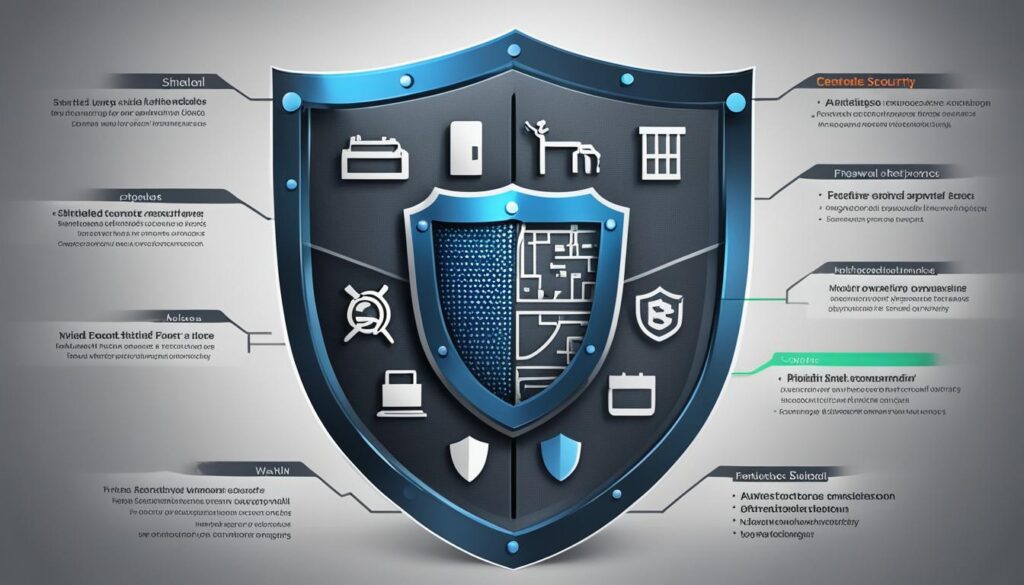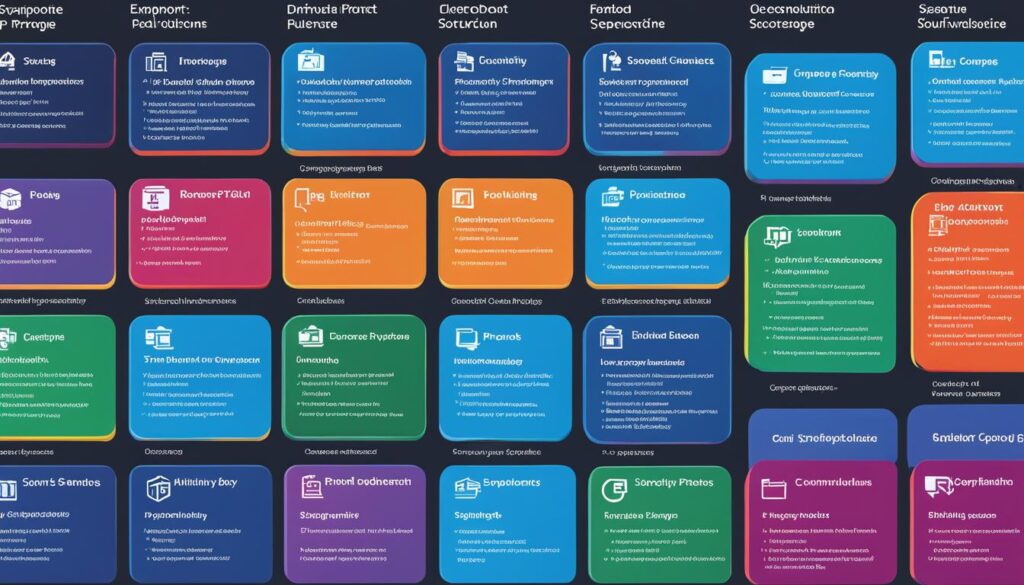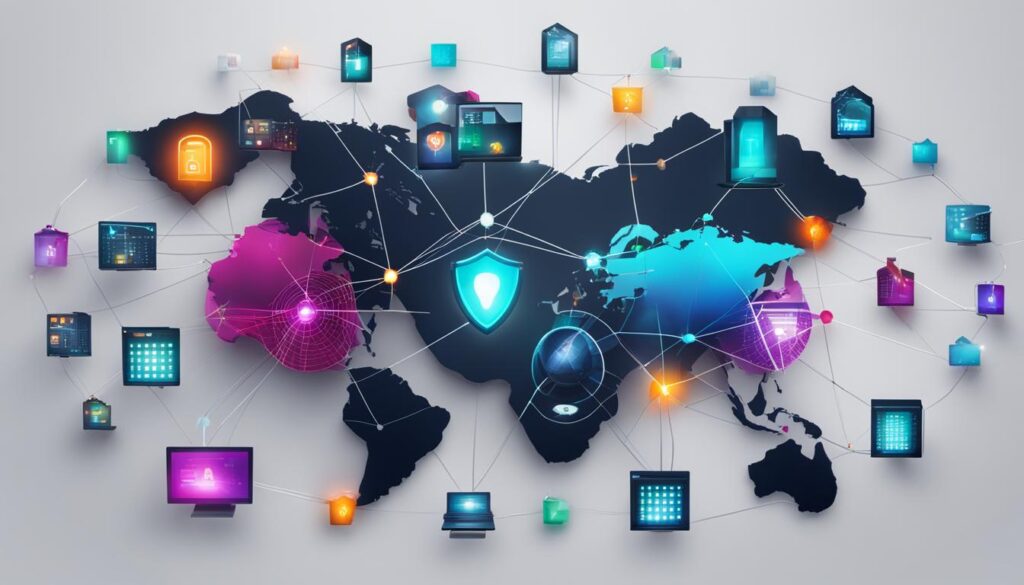Endpoint protection software is essential for safeguarding digital assets in today’s rapidly expanding threat landscape. In this comprehensive guide, we will explore the top endpoint protection software options available in 2024. The information provided is based on thorough evaluations and rankings from real users, ensuring an unbiased view of the market. Use this guide to compare features, evaluate user satisfaction, and make an informed decision about the best endpoint protection software for your organization’s needs.
Key Takeaways:
- Choose the best endpoint protection software to safeguard your organization’s digital assets.
- Base your decision on comprehensive evaluations and rankings from real users.
- Compare features to find the software that aligns with your organization’s specific needs.
- Evaluate user satisfaction to ensure a reliable and effective solution.
- Stay up-to-date with market trends to assess the long-term viability of your chosen endpoint protection software.
The Data Quadrant Buyer’s Guide
The Data Quadrant Buyer’s Guide is a valuable resource that provides a comprehensive evaluation of the top software in the Endpoint Protection market. It collects data from real users, verifies it meticulously, and presents it in easy-to-understand charts and graphs.
The guide compares each product against the best Endpoint Protection to give a holistic view of the product landscape. It measures user satisfaction with the software’s features and the likelihood of recommending it, as well as the vendor experience and capabilities.
This guide is a quick snapshot of the market and can help you validate your top features and shortlist your contenders.
With the Data Quadrant Buyer’s Guide, you can make an informed decision about the best endpoint protection software for your organization’s needs. Let’s take a look at an example quadrant to see how the data is presented:
Example Quadrant: Top Endpoint Protection Software
| Software | Overall Score | User Satisfaction | Likelihood to Recommend | Vendor Experience | Capabilities |
|---|---|---|---|---|---|
| Product A | 9.5 | 9.8 | 9.4 | 9.5 | 9.4 |
| Product B | 8.7 | 8.9 | 8.4 | 8.8 | 8.6 |
| Product C | 8.2 | 8.6 | 8.0 | 8.3 | 8.1 |
Based on the example quadrant above, Product A stands out as the top-ranked endpoint protection software, with high scores in overall satisfaction, likelihood to recommend, vendor experience, and capabilities.
Remember, the Data Quadrant Buyer’s Guide provides you with valuable insights and comparisons to help you navigate the endpoint protection software market. Use this guide to make a well-informed decision and choose the best solution for your organization.
The Emotional Footprint Buyer’s Guide
The Emotional Footprint Buyer’s Guide is a valuable resource that provides insights into the overall experience of working with endpoint protection software vendors and their platforms. By capturing user sentiment towards both the vendor and product, this guide offers a unique perspective on how vendors build relationships and support their customers.
The guide collects extensive data from users and rates their satisfaction with the software’s value, as well as their emotional response to the vendor. It includes a range of 25 data points covering various aspects such as contracting, support during conflicts, and product strategy. This comprehensive evaluation allows you to assess vendors based not only on functionality but also on emotional connection and support quality.
With the Emotional Footprint Buyer’s Guide, you can find vendors that prioritize building relationships and creating loyal customer bases. Use this resource to make an informed decision that considers not only the technical capabilities of the software but also the overall experience it provides.
The Best Security Suite Deals This Week
Looking to enhance your digital security? Take advantage of the best security suite deals available this week. These handpicked options provide a range of features and pricing options to meet different needs. Check out these top choices:
1. Bitdefender Total Security
Get comprehensive protection for up to 5 devices with Bitdefender Total Security’s 1-year plan.
2. Surfshark One
Safeguard up to 5 devices with Surfshark One’s robust security suite.
3. Aura Antivirus
Secure your devices with Aura Antivirus, offering protection for 3 devices.
4. Webroot Internet Security Complete
Take advantage of a time-limited offer with Webroot Internet Security Complete, ensuring comprehensive protection for your devices.
5. Norton 360 Deluxe
Protect up to 5 devices with Norton 360 Deluxe, a trusted name in digital security.
6. Bitdefender Internet Security
Experience reliable protection for 3 devices with Bitdefender Internet Security.
7. McAfee
Ensure unlimited device protection on a 1-year advanced plan with McAfee.
Don’t miss out on these exclusive deals to safeguard your digital assets. Choose the security suite that best fits your needs and enjoy peace of mind online.
| Security Suite | Number of Devices | Plan Duration | Special Offer |
|---|---|---|---|
| Bitdefender Total Security | Up to 5 | 1 year | – |
| Surfshark One | Up to 5 | – | – |
| Aura Antivirus | 3 | – | – |
| Webroot Internet Security Complete | – | Time-limited | Special offer available |
| Norton 360 Deluxe | Up to 5 | – | – |
| Bitdefender Internet Security | 3 | – | – |
| McAfee | Unlimited | 1 year | Advanced plan |

What Is Endpoint Security Software?
Endpoint security software is a critical component in safeguarding company assets and maintaining robust security policies across various devices. In today’s digital landscape, where advanced malware and network intrusions are prevalent, endpoint security software plays a vital role in detecting and preventing these threats. It provides comprehensive protection against known and unknown attacks, ensuring the security of company assets.
With the increasing number of devices used by employees and the rise in remote work, the attack surface for potential threats is expanding rapidly. Endpoint security software utilizes advanced technologies such as AI, machine learning, and up-to-date threat intelligence to effectively respond to these evolving threats.
If a breach is detected, automated processes within the endpoint security software isolate, investigate, and remove suspicious code promptly. This automated response helps maintain the integrity of the system and prevents further damage.
Companies can rely on endpoint security software to enforce security policies across all devices, ensuring that sensitive data is protected and compliance requirements are met. By leveraging cutting-edge technologies and proactive threat intelligence, organizations can enhance their security posture and mitigate the risks posed by advanced malware and network intrusions.
Let’s take a look at how endpoint security software contributes to the protection of company assets:
- Enforcing Security Policies: Endpoint security software ensures that security policies are consistently enforced across all devices, reducing the risk of unauthorized access and data breaches.
- Detecting and Preventing Advanced Malware: With its advanced threat detection capabilities, endpoint security software can identify and block sophisticated malware that traditional security solutions may miss.
- Responding to Network Intrusions: Endpoint security software employs real-time monitoring and response mechanisms to detect and respond to network intrusions promptly, minimizing the impact of potential breaches.
By implementing endpoint security software, organizations can effectively protect their valuable assets, preserve the confidentiality of sensitive information, and maintain a strong security posture in today’s ever-evolving threat landscape.

Common Features of Endpoint Security Software
Endpoint security software offers a range of common features that enhance protection and visibility.
- Next-Generation Antivirus (NGAV): Goes beyond traditional signature-based detection to provide advanced threat protection.
- Fileless Malware Prevention: Counters attacks that execute in memory, preventing fileless malware from infiltrating systems.
- Centralized Management and Reporting: Provides a single interface for managing and monitoring security across all endpoints.
- Endpoint Detection and Response (EDR): Enables continuous monitoring and investigation of intrusions, allowing for swift response and remediation.
- Threat Intelligence: Delivers real-time data on emerging threats, empowering security teams to proactively defend against attacks.
- Sandbox Environments: Offers secure environments for analyzing and removing suspicious code, preventing potential threats from affecting the network.
- Threat Hunting: Proactively searches for evidence of intrusion, identifying potential threats before they cause harm.
- Port and Device Control: Restricts access to removable media and provides granular control over connected devices.
These features work together to create a comprehensive endpoint security solution, ensuring organizations have robust protection against evolving threats.

What Type of Buyer Are You?
Endpoint security is essential for businesses of all sizes, including small businesses, mid-size companies, and enterprise businesses. The right endpoint security software can help protect your company’s digital assets and maintain a strong cybersecurity posture. When it comes to choosing the appropriate endpoint security solution, it’s important to consider your specific requirements and the scale of your operations.
Small Businesses
For small businesses, endpoint security software offers core features that provide a significant upgrade over traditional antivirus packages. These features include real-time threat detection, malware prevention, and centralized management. With a budget-friendly solution tailored to their needs, small businesses can enhance their security without breaking the bank.
Mid-Size Companies
Mid-size companies often have more complex cybersecurity needs. They require advanced features such as proactive threat intelligence, threat hunting capabilities, and endpoint detection and response (EDR) tools. These features allow mid-size companies to stay one step ahead of evolving threats and quickly respond to security incidents.
Enterprise Businesses
Enterprise businesses operate on a larger scale with a higher number of endpoints. They need robust endpoint security solutions that offer enterprise-level features like advanced threat intelligence, automated incident response, and integrated security analytics. With the ability to handle a massive volume of data and protect a vast network, enterprise businesses can ensure comprehensive security across all endpoints.
Ultimately, the choice of endpoint security software depends on the specific needs and requirements of your business. It’s important to evaluate different options, considering factors such as budget, scalability, and the level of cybersecurity expertise within your organization. By selecting the right endpoint security software, you can safeguard your digital assets and protect your business from evolving cyber threats.
Benefits and Potential Issues
Endpoint security software offers several benefits in today’s evolving business environment. With the expanding security perimeter due to remote work and bring your own device (BYOD) policies, organizations can gain control over their security landscape.
One of the key advantages of endpoint security software is its ability to provide simplified remote security without disrupting device usability. This ensures that employees can work efficiently from anywhere, while maintaining the highest level of protection for company assets.
However, it’s important to consider potential issues that may arise. Some advanced endpoint security products may require dedicated resources for maintenance, such as a full-time administrator. This can impact the overall cost and operational efficiency of the solution.
Additionally, reliability is a crucial aspect to consider when selecting endpoint security software. Different options may vary in terms of accuracy and false positives, which can affect the overall effectiveness of the solution in detecting threats.
Thorough research and evaluation are necessary to ensure the chosen endpoint security software meets the specific needs of the organization, taking into account control, simplified remote security, dedicated resources, and reliability.
| Benefits | Potential Issues |
|---|---|
|
|

Endpoint Security Software Pricing
Pricing for endpoint security software is typically based on the number of endpoints that require protection. These endpoints can include devices, web applications, and servers. Instead of charging per user, organizations are billed according to the total number of endpoints.
When evaluating pricing options for endpoint security software, it is crucial for organizations to consider their specific endpoint count. This will ensure they choose a solution that aligns with their needs and budget.
Below is a breakdown of the general pricing models for endpoint security software:
- Per Endpoint: Some vendors offer pricing based on a per-endpoint basis. This model allows organizations to pay for the exact number of endpoints they need to protect.
- Devices, Web Applications, and Servers: Pricing can also be based on the number of devices, web applications, and servers that require protection. This model is suitable for organizations with a complex infrastructure.
“Choosing the right pricing model for your organization is crucial in ensuring cost-effectiveness and maximum protection of your endpoints.”
It’s important to note that pricing may vary between vendors and may also be influenced by additional factors such as the level of features and functionality offered.
To help you understand the pricing landscape of endpoint security software, here is an example of a pricing comparison:
| Vendor | Pricing Model | Features |
|---|---|---|
| Vendor A | Per Endpoint | NGAV, EDR, threat hunting |
| Vendor B | Devices, Web Applications | NGAV, sandboxing, threat intelligence |
| Vendor C | Servers | EDR, fileless malware prevention, port control |

As you can see from the example, different vendors offer varying pricing models and feature sets. It’s essential to carefully evaluate each vendor’s pricing structure and features to ensure you choose the best solution for your organization.
By considering your specific endpoint count and comparing pricing options, you can make an informed decision that maximizes both protection and cost-effectiveness for your organization.
Market Trends to Understand
The endpoint security market is undergoing significant changes and consolidation, driven by the need for enhanced protection against evolving cyber threats. One key trend in this evolving market is the integration of endpoint detection and response (EDR) tools with other features to create unified solutions accessible from a single dashboard.
This consolidation simplifies endpoint management and visibility, allowing organizations to streamline their security operations and respond more effectively to potential threats. By combining EDR capabilities with other security features, businesses gain a comprehensive and centralized view of their endpoint security posture.
Looking ahead, future trends in the endpoint security market indicate the incorporation of additional features to address emerging challenges. These include authentication management to ensure secure access and identity verification, IoT security to protect the growing number of connected devices, and IT hygiene practices to maintain a clean and secure IT environment.
As the threat landscape continues to evolve, it is crucial for buyers to stay informed about these market trends. Understanding the long-term direction of endpoint security software can help organizations make informed decisions and choose solutions that will remain relevant and effective in the face of evolving cyber threats.
Key Market Trends:
- Integration of endpoint detection and response (EDR) tools with other features
- Unified solutions accessible from a single dashboard
- Incorporation of authentication management to ensure secure access
- Focus on IoT security to protect connected devices
- Emphasis on IT hygiene practices for a clean and secure IT environment

Conclusion
In conclusion, selecting the right endpoint protection software is crucial for organizations in safeguarding their digital assets and maintaining a strong cybersecurity posture. By considering factors such as features, buyer type, pricing, and market trends, organizations can make an informed decision that aligns with their specific requirements.
Remember to evaluate user satisfaction, compare functionalities, and prioritize the protection measures that align with your organization’s threat landscape. By leveraging the information provided in this guide, you can unlock the top endpoint protection software choices in 2024 and ensure the security of your digital assets.
FAQ
What is endpoint protection software?
Endpoint protection software is a security solution designed to safeguard digital assets by enforcing security policies, detecting and preventing advanced malware, and responding to network intrusions.
How can endpoint security software enhance protection?
Endpoint security software offers features such as next-generation antivirus, fileless malware prevention, centralized management and reporting, endpoint detection and response, threat intelligence, sandbox environments, threat hunting, and port and device control to create a comprehensive security solution.
Who can benefit from endpoint security software?
Endpoint security software is relevant to businesses of all sizes. Small businesses can benefit from core features, while mid-size and enterprise companies often require advanced features to address their larger cybersecurity needs.
What are the benefits and potential issues of endpoint security software?
Endpoint security software provides simplified remote security, control over expanding security perimeters, and a range of protection measures. However, advanced solutions may require dedicated resources, and reliability can vary among different options.
How is endpoint security software priced?
Endpoint security software is typically priced based on the number of endpoints that require protection, including devices, web applications, and servers. Buyers should consider their specific endpoint count when evaluating pricing options.
What are the market trends in endpoint security software?
The endpoint security market is evolving and consolidating, with detection and response tools merging into unified solutions accessible from a single dashboard. Future trends may include additional features such as authentication management, IoT security, and IT hygiene.


